Finnish cuisine is a hearty blend of traditional ingredients and preservation methods shaped by the harsh climate. You’ll find rye bread, smoked fish, game meats, and wild berries at its core, often prepared through slow cooking, smoking, or fermenting. Influenced by Scandinavian and European traditions, it emphasizes resourcefulness and seasonal foods. If you want to discover how these elements come together in iconic dishes and regional flavors, there’s much more to explore.
Key Takeaways
- Finnish cuisine is shaped by its cold climate, emphasizing preservation techniques like smoking, drying, and fermentation for year-round food security.
- Key ingredients include rye, oats, potatoes, fish (salmon, herring), game meats, dairy, berries, and mushrooms, with regional and seasonal variations.
- Traditional dishes feature hearty stews, smoked and cured meats, rye bread, and baked pastries like *karjalanpiirakka* and cinnamon buns.
- Scandinavian, Russian, and German influences enrich Finnish culinary traditions with spices, preserved foods, and coffee culture.
- Preservation methods foster social bonds, sustain food security, and reflect Finland’s resourcefulness and cultural heritage.
The Origins and Evolution of Finnish Food Culture
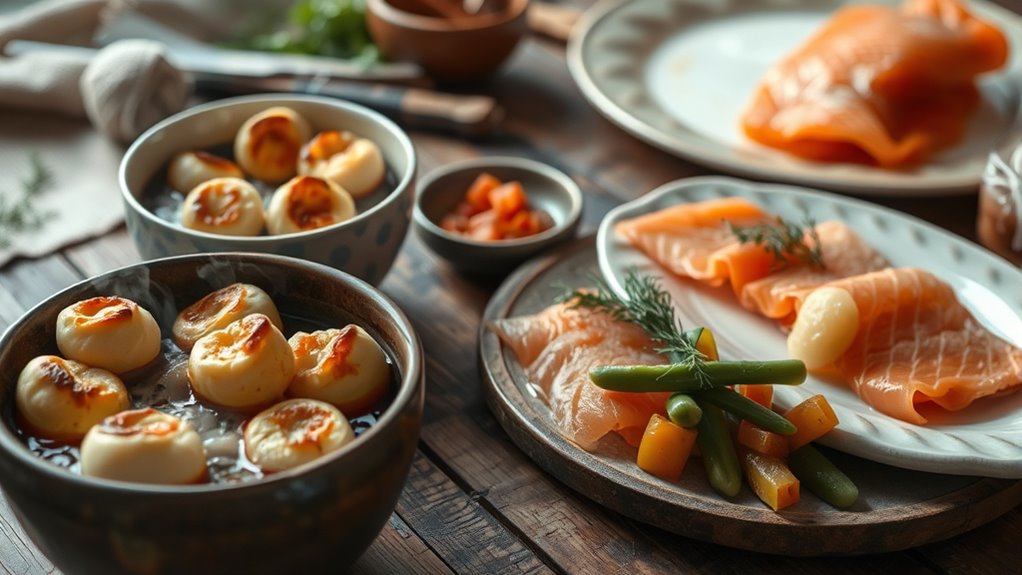
Finnish food culture has developed over centuries in response to the country’s challenging climate and geographical conditions. You’ll notice that preservation methods like smoking, drying, and salting became essential because short summers limited fresh supplies. Traditional ingredients such as potatoes, whole grains, dairy, and various meats formed the backbone of the diet. Finnish cuisine also reflects influences from Swedish, Russian, and German rule, shaping dishes and customs. Coffee, introduced by Swedish rulers, became a cultural staple and remains a daily ritual. Throughout history, seasonal and regional variations emerged, especially in the north and south. The blend of practicality and adaptation created a resilient culinary identity that balances rustic flavors with evolving influences, laying the foundation for modern Finnish cuisine. Additionally, hackathons have become a platform for innovative food solutions, fostering collaboration among chefs, technologists, and entrepreneurs to address challenges in sustainable and efficient food production.
Key Ingredients and Staples in Finnish Kitchens

In Finnish kitchens, you’ll find that grains like rye, oats, and barley form the backbone of many dishes, especially bread and porridge. Proteins such as fish, game meats, and reindeer are staples, often prepared through smoking, curing, or slow cooking. Dairy products like cheese and fermented milk play a daily role, reflecting Finland’s long-standing culinary traditions. Emphasizing leadership skills can also be valuable when exploring the cultural significance of these traditional foods and recipes.
Essential Grain Varieties
Rye stands out as the most essential grain in Finnish kitchens, serving as the foundation for many traditional dishes. You’ll find rye in the iconic rye bread (ruisleipä), which is a staple at nearly every meal. It’s valued for its hearty flavor and long shelf life, perfect for Finland’s cold climate. Barley and oats also play important roles, especially in porridges, soups, and baked goods. Oats, in particular, are used for making oatcakes and muesli, reflecting the country’s agricultural heritage. These grains are often grown locally, ensuring freshness and supporting traditional farming practices. Whether in bread, porridge, or baked treats, these grains embody Finland’s rustic, hearty cuisine and are central to maintaining its culinary identity.
Popular Protein Sources
What are the main sources of protein that sustain Finnish cuisine? You’ll find that meats like reindeer, moose, deer, and game are traditional staples, especially in Lapland and eastern regions. Fish, especially freshwater varieties like salmon, perch, and vendace, are central to many dishes, often smoked, cured, or used in soups. Poultry and pork also play significant roles, with sausages and hams common in home cooking. Wild berries and mushrooms supplement protein intake, often used in sauces or as part of preserved foods. Dairy products like cheeses, fermented milk, and sour curds are essential for daily nutrition. These sources reflect Finland’s history of food preservation and the reliance on local, seasonal ingredients to sustain its population through long, harsh winters. Additionally, local hunting traditions have historically contributed to the diversity of protein sources in Finnish cuisine.
Common Dairy Products
Finnish kitchens rely heavily on a variety of dairy products that have been integral to their traditional cuisine for centuries. You’ll find dairy in everyday dishes, from breakfast to dessert, providing richness and flavor. Common dairy staples include cheeses like leipäjuusto, a soft, squeaky cheese often served warm, and fermented milk products such as viili and fiili, used in breakfast and baking. These products are valued for their preservation qualities and unique textures. Incorporating dairy also reflects Finland’s culinary heritage, emphasizing traditional methods and local ingredients.
| Dairy Product | Typical Use |
|---|---|
| Leipäjuusto | Served warm with jam or coffee |
| Viili | Breakfast, baking, sauces |
| Fermented milk | Drinking, cooking, desserts |
Dairy’s role reflects Finland’s reliance on local, traditional methods, shaping the country’s culinary identity.
Traditional Finnish Dishes and Their Preparation Methods
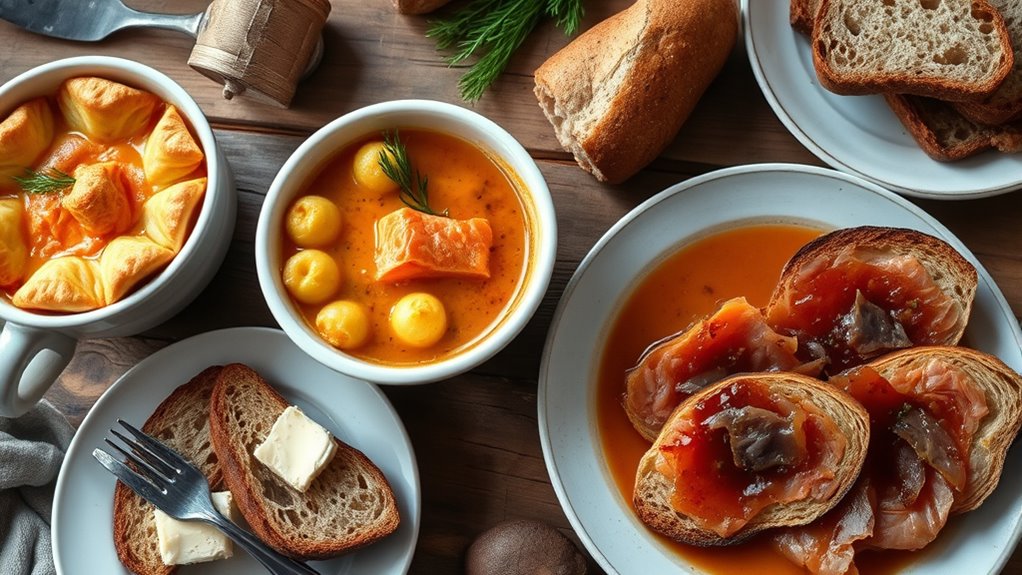
Traditional Finnish dishes showcase a deep connection to the country’s harsh climate and resourcefulness, relying on methods like slow cooking, smoking, drying, and fermentation to preserve ingredients and develop rich flavors. You often prepare hearty stews such as karjalanpaisti by simmering meats with vegetables, using slow heat to tenderize tough cuts. Smoking and drying are common for meats and fish, like salmon or Baltic herring, enhancing flavor and shelf life. Fermentation is essential for dairy products like viili and sour milk, adding tang and texture. Baked goods such as rye bread and karjalanpiirakka highlight simple, traditional techniques like baking and steaming. These methods reflect Finland’s adaptation to limited growing seasons, emphasizing preservation and flavor concentration in every dish. Incorporating eco-friendly techniques, such as traditional smoking and drying, further underscores Finland’s sustainable approach to food preservation.
Preservation Techniques and Their Significance
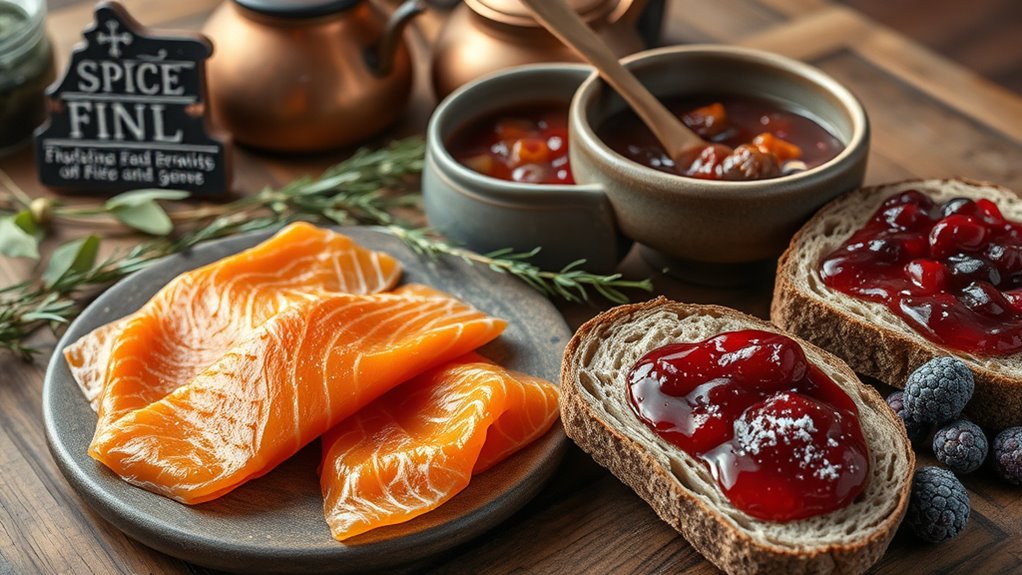
You recognize that preservation techniques like smoking, drying, and salting are vital for Finnish cuisine, especially given the harsh winters. These methods not only extend the shelf life of meats and fish but also shape cultural traditions passed down through generations. Understanding their significance helps you appreciate how Finnish communities maintain their food heritage year-round. Additionally, these techniques are closely related to traditional food preservation methods, which have been adapted over centuries to ensure food security in challenging climates.
Traditional Preservation Methods
Because of Finland’s harsh climate and short growing seasons, early inhabitants relied heavily on preservation techniques to guarantee food availability year-round. You’ll find that smoking, drying, and salting were essential methods for maintaining meat and fish. These techniques allowed you to store protein for months, especially during winter. Additionally, electricity production from bike generators was explored in modern times as a sustainable energy source, showcasing how traditional methods of preservation coexist with innovative solutions today. Fermentation also played a role, especially in dairy products like viili and sour milk curds. These methods are deeply rooted in Finnish culinary history, shaping how you prepare and enjoy food today.
Cultural Significance
Have you ever wondered how Finnish communities managed to preserve food through long, harsh winters? Preservation techniques like smoking, drying, and salting became essential, shaping cultural identity. These methods allowed communities to store essential proteins, dairy, and berries, ensuring survival and tradition. Preservation also fostered social bonds during communal processing and shared meals. Additionally, these techniques exemplify traditional preservation methods that have been passed down through generations. Below is a table highlighting key techniques and their cultural significance:
| Technique | Cultural Significance |
|---|---|
| Smoking | Connects to festive traditions and regional flavors |
| Drying | Symbolizes self-sufficiency and resourcefulness |
| Salting | Preserves heritage of fisher and hunter communities |
| Fermentation | Enhances flavors and sustains dairy traditions |
| Curing | Reinforces communal bonds during long winters |
These methods embody resilience, regional identity, and a deep respect for nature’s cycles.
Regional and Seasonal Variations in Finnish Cuisine
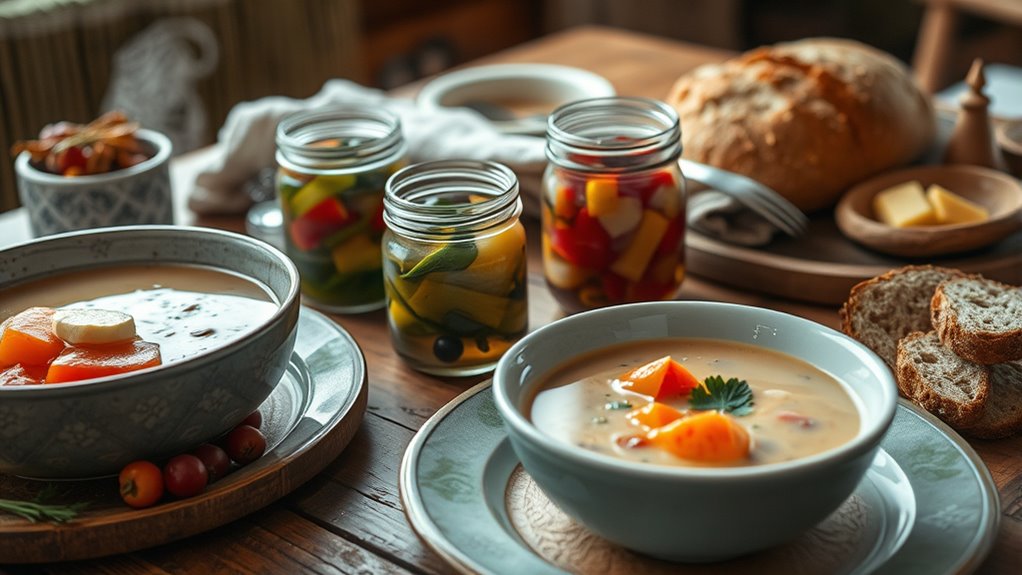
Finnish cuisine varies considerably across regions and seasons, shaped by the country’s diverse climates and natural resources. You’ll notice northern Finland relies more on rye, smoked meats, and preserved foods due to its harsher environment. In contrast, southern regions favor wheat, oats, and fresh salted fish, reflecting milder weather and richer fishing opportunities. The east, especially Karelia, features hearty mushroom dishes and oven-baked stews with cubed meats, while Lapland emphasizes reindeer and game meats, served with lingonberry jam. Coastal areas focus on Baltic herring and other salted or grilled fish, reflecting their fishing heritage. Seasonal changes influence ingredients and dishes, with preservation methods like drying and smoking used heavily during winter, and fresh, foraged ingredients prominent in summer. Incorporating traditional preservation techniques is essential to maintaining the authentic flavors throughout the year.
The Role of Wild Foraged Foods and Game Meats

Wild foraged foods and game meats are essential to Finnish cuisine, deeply rooted in the country’s natural landscape and seasonal cycles. You’ll find wild berries like lingonberries and bilberries used in jams, sauces, and desserts, highlighting Finland’s rich foraging tradition. Mushrooms such as chanterelles and porcini are gathered in forests and incorporated into stews, soups, or served sautéed. Game meats like moose, deer, and hare are traditional proteins, often prepared as roasts, stews, or sausages, especially in regions where hunting is common. Reindeer, a regional delicacy in Lapland, features prominently in local dishes served with lingonberry jam and mashed potatoes. These ingredients emphasize Finland’s connection to nature, seasonal availability, and sustainable practices, shaping authentic culinary experiences. Incorporating local ingredients not only supports sustainable practices but also enhances the authentic flavors of Finnish cuisine.
Finnish Baking and Popular Pastries

Baking holds a special place in Finnish cuisine, blending traditional techniques with Scandinavian flavors. You’ll find that Finnish pastries emphasize hearty ingredients and simple methods.
Baking in Finland combines tradition and simplicity, highlighting hearty ingredients and Scandinavian culinary influences.
- Rye-based breads, like ruisleipä, are staples, often dense and dark, perfect for everyday meals.
- Korvapuusti, cinnamon buns with their signature pinched shape, are beloved sweet treats enjoyed with coffee.
- Karjalanpiirakka, a rye crust pastry filled with rice or mashed potatoes, is a common snack or breakfast item.
These baked goods highlight Finland’s resourcefulness, using local grains and dairy. Many recipes have been passed down through generations, maintaining a rustic charm while adapting to modern tastes. Whether hearty or sweet, Finnish baked goods reflect regional traditions and a love for comforting, wholesome flavors.
Influence of Scandinavian and European Traditions on Finnish Flavors
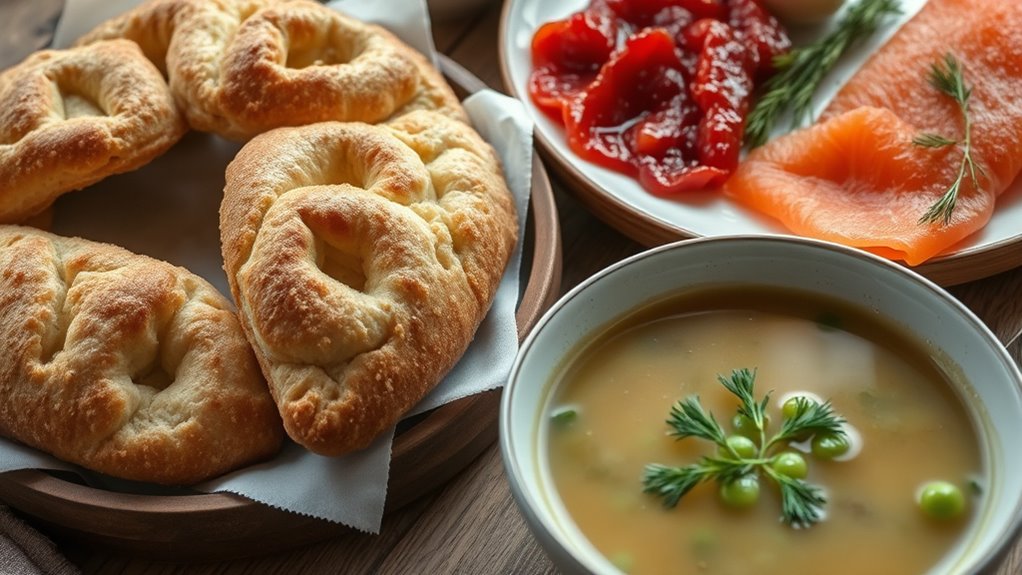
Have you ever noticed how Scandinavian and European traditions subtly shape Finnish flavors? You’ll find that Scandinavian influences, especially Swedish, bring cinnamon, cardamom, and baked fish into Finnish dishes, reflecting a shared love for pastries like korvapuusti and hearty seafood. European influences, particularly from Germany and Russia, introduce richer spices, preserved meats, and sour dairy products. Finnish cuisine incorporates these elements through the use of warm spices in baked goods, smoked and cured fish, and robust stews. Coffee culture, a Swedish import, remains central to social life, often served alongside traditional pastries. These influences blend seamlessly into Finland’s culinary identity, creating a unique flavor profile that balances rustic ingredients with subtle European sophistication. The result is a cuisine that feels both familiar and distinctly Finnish.
Modern Trends and the Future of Finnish Culinary Heritage

Finnish cuisine is evolving as modern trends blend traditional flavors with innovative techniques and global influences. You’ll notice a shift toward sustainable and locally sourced ingredients, emphasizing organic farming and foraging. Chefs incorporate Nordic minimalism, focusing on presentation and flavor purity. Additionally, plant-based foods are gaining popularity, reflecting health-conscious lifestyles.
Finnish cuisine blends tradition with innovation, emphasizing sustainability, Nordic minimalism, and plant-based flavors.
- You’ll see innovative dishes that combine old recipes with contemporary twists, like reimagined rye bread or reindeer dishes with global spices.
- Fusion cuisine is expanding, blending Finnish ingredients with international techniques, creating new culinary experiences.
- Food tech, such as fermentation and alternative proteins, is shaping the future of Finnish dining.
These trends preserve Finland’s culinary identity while embracing innovation, ensuring its heritage remains vibrant and relevant.
Frequently Asked Questions
How Does Finnish Cuisine Incorporate Indigenous Ingredients and Traditional Preservation Methods?
You incorporate Finnish cuisine’s indigenous ingredients by using wild berries like lingonberries and bilberries in jams and desserts. You also include freshwater fish such as salmon and perch, often smoked or cured for preservation. Traditional methods like drying, salting, and smoking are key, especially for meats and fish, helping you preserve these ingredients for long winters. These techniques and ingredients define Finland’s rustic, resourceful culinary heritage.
What Are Unique Regional Dishes Specific to Northern, Eastern, and Coastal Finland?
In northern Finland, you’ll find reindeer dishes served with lingonberry jam and mashed potatoes, showcasing game meat popularity. Eastern Finland offers hearty oven-baked stews with mushrooms and cubed meat, reflecting forest foraging. Coastal regions emphasize Baltic herring, grilled or salted, highlighting their fishing heritage. These regional dishes reveal how local ingredients like game, fish, and wild berries shape distinct culinary identities across Finland’s landscapes.
How Have Finnish Culinary Influences Evolved With Modern European and Global Cuisines?
You’ve seen how Finnish cuisine has evolved by blending traditional ingredients with modern European and global influences. You’ll notice new techniques, spices, and diverse ingredients enriching classic dishes, creating a fusion of old and new. You might enjoy innovative pastries, international flavors in seafood, or contemporary Nordic-style plating. This culinary evolution reflects Finland’s openness to global trends while still honoring its rustic, seasonal roots, making its cuisine both unique and versatile today.
In What Ways Do Seasonal Changes Affect Traditional Finnish Food Practices?
Imagine you’re stuck in a snowstorm, and seasonal changes greatly impact Finnish food practices. In winter, you rely on preserved meats, smoked fish, and hearty stews like karjalanpaisti, which keep you warm. During short summers, you forage for berries and mushrooms, enjoying fresh salads and lighter dishes. This shift helps you adapt, balancing preservation techniques with seasonal ingredients, ensuring you enjoy Finnish flavors year-round despite the harsh climate.
What Role Do Foraged Berries and Mushrooms Play in Everyday Finnish Cooking?
You often incorporate foraged berries and mushrooms into your everyday cooking, adding fresh, local flavors. Lingonberries, bilberries, and wild mushrooms like chanterelles or porcini become jams, sauces, or ingredients in soups and stews. These ingredients are prized for their seasonal availability and natural preservation. By foraging yourself, you connect with Finland’s rich natural resources, enriching your meals with authentic, regional tastes that highlight the country’s deep relationship with nature.
Conclusion
So there you have it—Finland’s culinary journey from humble ingredients to trendy dishes. With a history rich in preservation and foraging, you might think Finnish food is stuck in the past. But don’t worry—today’s chefs are blending tradition with innovation, proving that even the coldest kitchens can warm up with a dash of creativity. Who knew that a country known for snow could also serve up a hot new food scene?










